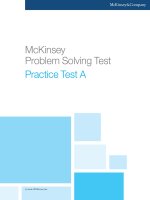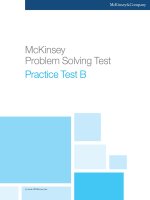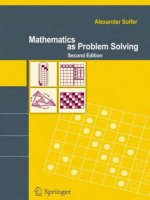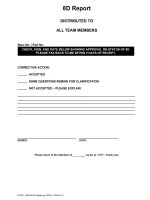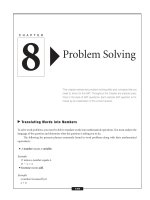Mar 29 problem solving
Bạn đang xem bản rút gọn của tài liệu. Xem và tải ngay bản đầy đủ của tài liệu tại đây (1.69 MB, 65 trang )
Teaching and Learning
Mathematics through
Problem Solving
Facilitator’s Handbook
A Guide to Effective Instruction in
Mathematics, Kindergarten to Grade 6
(with reference to Volume Two)
The Literacy and Numeracy Secretariat Professional Learning Series
Aims of Numeracy Professional
Learning
• Promote the belief that all students have learned some
mathematics through their lived experiences in the world
and that the mathematics classroom is one where
students bring that thinking to their work
• Build teachers’ expertise at setting classroom conditions
where students can move from their informal math
understandings to generalizations and formal
representations of their mathematical thinking
• Assist educators working with teachers of students in the
junior division to implement student-focused instructional
methods referenced in A Guide to Effective Instruction in
Mathematics, Kindergarten to Grade 6 to improve student
achievement
2
Aims continued
• Have teachers experience mathematical problem solving as
a model of what effective math instruction entails by:
– collectively solving problems relevant to students’ lives that
reflect the expectations in the Ontario mathematics
curriculum
– viewing and discussing the thinking and strategies in the
solutions
– sorting and classifying the responses to a problem to
provide a visual image of the range of experience and
understanding of the mathematics
– analysing the visual continuum of thinking to determine
starting points and next steps for instruction
3
Overall Learning Goals for
Problem Solving
During this session, participants will:
• become familiar with the notion of learning
mathematics for teaching as a focus for
numeracy professional learning
• experience learning mathematics through
problem solving
• solve problems in different ways
• develop strategies for teaching mathematics
through problem solving
4
Effective Mathematics Teaching
and Learning
Mathematics classrooms must be challenging and
engaging environments for all students, where
students learn significant mathematics.
Students are called to engage in solving rich and
relevant problems. These problems offer several
entry points so that all students can achieve, given
sufficient time and support.
Lessons are structured to build on students’ prior
knowledge.
Agree, Disagree, Not Sure
5
Effective Mathematics Teaching
and Learning continued
Students develop their own varied solutions to
problems and thus develop a deeper understanding
of the mathematics involved.
Students consolidate their knowledge through
shared and independent practice.
Teachers select and/or organize students’ solutions
for sharing to highlight the mathematics learning
(e.g., bansho, gallery walk, math congress).
Teachers need specific mathematics knowledge and
mathematics pedagogy to teach effectively.
Agree, Disagree, Not Sure
6
What Does It Mean to Learn
Mathematics for Teaching?
7
Deborah Loewenberg Ball
Mathematics for Teaching
• Expert personal knowledge of subject matter is
often, ironically, inadequate for teaching.
• It requires the capacity to deconstruct one’s own
knowledge into a less polished final form where
critical components are accessible and visible.
• Teachers must be able to do something perverse:
work backward from a mature and compressed
understanding of the content to unpack its
constituent elements and make mathematical ideas
accessible to others.
• Teachers must be able to work with content for
students while it is in a growing and unfinished
state.
8
What Do Teachers Need to Know and
Be Able to Do Mathematically?
• Understand the sequence and relationship between
math strands within textbook programs and materials
within and across grade levels
• Know the relationship between mathematical ideas,
conceptual models, terms, and symbols
• Generate and use strategic examples and different
mathematical representations using manipulatives
• Develop students’ mathematical communication –
description, explanation, and justification
• Understand and evaluate the mathematical significance
of students’ comments and coordinate discussion for
mathematics learning
9
Why Study Problem Solving?
10
Why Study Problem Solving?
11
Why Study Problem Solving?
12
Why Study Problem Solving?
EQAO suggests that
• a significant number of Grades 3 and 6 students
exhibited difficulty in understanding the demands of
open-response problem-solving questions in
mathematics
• many Grades 3 and 6 students, when answering openresponse questions in mathematics, had difficulty
explaining their thinking in mathematical terms
Excerpted from EQAO. (2006). Summary of Results and Strategies for Teachers:
Grade 3 and 6 Assessments of Reading, Writing, and Mathematics, 2005 –2006
13
An Overview
14
A Guide to Effective Instruction in
Mathematics, Kindergarten to Grade 6
Volume 5:
Teaching Basic
Facts and Multidigit
Computations
Volume 1:
Foundations of
Mathematics Instruction
Volume 2:
Problem Solving and
Communication
Volume 3:
Classroom
Resources and
Management
Volume 4:
Assessment and
Home Connections
In What Ways Does A Guide to
Effective Instruction in Mathematics
Describe Problem Solving?
1. List 2 ideas about problem
solving that are familiar.
2. List 2 ideas about problem
solving that are unfamiliar.
3. List 2 ideas about problem
solving that are puzzling.
Familiar, Unfamiliar, Puzzling
solving>
15
Problem Solving
Session A
Activating Prior
Knowledge
16
Learning Goals of the Module
Experience learning mathematics through
problem solving by:
• identifying what problem solving looks,
sounds, and feels like
• relating aspects of Polya’s problem-solving
process to problem-solving experiences
• experiencing ways that questioning and
prompts provoke our mathematical thinking
17
Curriculum Connections
18
Curriculum Connections
19
Warm Up – Race to Take Up Space
Goal:
To cover the game board with rectangles
Players: 2 (individual) to 4 (teams of 2)
Materials: 7x9 square tiles grid game board, 32 samecolour square tiles per player, 2 dice
How to Play:
1.
Take turns rolling the dice to get 2 numbers.
2.
Multiply the 2 dice numbers to calculate the area of a
rectangle (e.g., 4, 6 area = 24 square units).
3.
Construct a rectangle of the area calculated, using
square tiles of the same colour.
4.
Place your rectangle on the game board.
5.
Lose a turn if the rectangle you constructed cannot
be placed on the empty space on the game board.
6.
The game ends when no more rectangles can be placed on
the game board. Which player is left with the most tiles?
20
Working on It – Carpet Problem
Hello Grade 4 students,
1. What is the problem to
solve?
The carpet you have been
asking for arrives tonight.
Please clear a space in your
room today that will fit this
new carpet. The perimeter
of the carpet is 12 m.
2. Why is this problem a
problem?
From your principal
3. Show two different ways
to solve this carpet
problem.
4. How do you know we
have all the possible
solutions?
A Guide to Effective Instruction, Vol. 2 – Problem Solving, pp. 18–25
21
Look Back – Reflect and Connect
How Were the Students Solving the Problem?
Read one page from the
“Problem Solving
Vignette” on pp. 18–25.
1. What mathematics was evident in
the students’ development of a
solution to the carpet problem?
2. Describe the mathematical
processes that the students were
using to develop a solution.
3. Provide specific details from the
vignette text to justify your
description.
Mathematical Processes
a) problem solving
b) reasoning and
proving
c) reflecting
d) selecting tools and
computational
strategies
e) connecting
f) representing
g) communicating
22
Look Back continued
Focus on the one or two
pages that you read from
the “Problem- Solving
Vignette.”
4. What questions does the
teacher ask to make the
problem-solving process
explicit?
5. What strategies does the
teacher use to engage all the
students in solving this carpet
problem?
Polya’s Problem-Solving Process
Understand the Problem
Communicate – talk to understand the
problem
Make a Plan
Communicate – discuss ideas with others to
clarify strategies
Carry Out the Plan
Communicate – record your thinking using
manipulatives, pictures, words, numbers,
and symbols
Look Back
Communicate – verify, summarize/
generalize, validate, and explain
23
Next Steps in Our Classroom
1. Describe two strategies from the “ProblemSolving Vignette” that you use and two
strategies that you will begin to use in your
classroom to engage students in problem
solving.
2. Keep a written record of the questions that you
ask to make the problem-solving process
explicit.
3. Practise noticing the breadth of mathematics
that students use in their solutions.
4. During class discussions, make explicit
comments about the mathematics students are
showing in their solutions.
24
Problem Solving
Session B
Modelling and
Representing
Area
25
